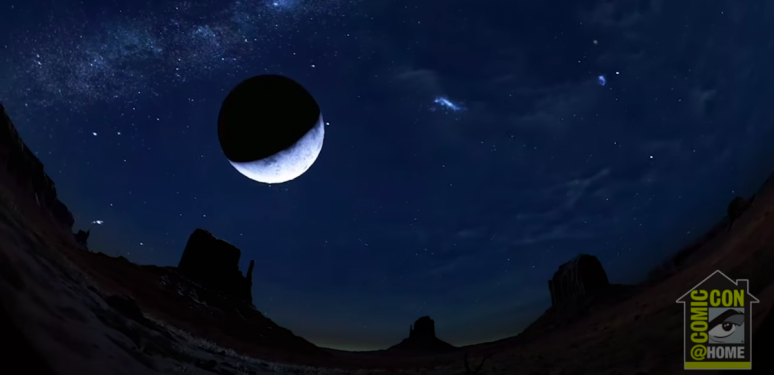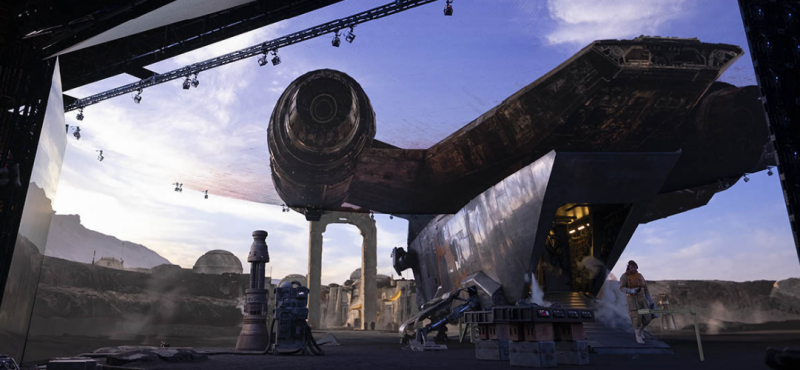Star Wars fans rejoiced when Disney+ announced that one of the platform’s first original series would be an extension of the much loved sci-fi universe. To produce that series, The Mandalorian, showrunners had to create believable far-away worlds that would work within the existing Star Wars landscape and give fans a new take on the galaxy. This challenge drove the development of a revolutionary new way to make TV, involving digital landscapes, video game software, and a digital stage that makes the Holodeck look like a prototype.
Those far-far away planets were created by The Mandalorian’s visual-effects team at Halon Entertainment. In a recent virtual panel for the international Comic-Con convention, several members of the company discussed the gamut of new technologies employed to create today’s effects. Thanks to one crucial resource, high-speed broadband, these technologies were able to be employed remotely, allowing production to continue even during a pandemic.
The Location Comes to the Crew
One of the most revolutionary technologies employed to produce The Mandalorian was a partially digital set. This approach blends physical elements with digital technology in a way viewers haven’t seen before. “We can go to a [location] and take a couple of thousand pictures and rebuild that in a software package…” Halon’s Visual Art Department Supervisor, Kenny DiGiordano, explains, “You can bring that into a lightbox room and take photos…and now you have the same exact box on set in The Mandalorian room and it’s the same exact thing that appears on screen.” These digital sets are then brought into Unreal Engine, a technology platform used to develop open-world video games with an incredible level of fidelity. Having the set built as a 3D digital file means adjustments can be made, lighting can be totally controlled, and only one stage is needed for filming.
This soup-to-nuts virtual production process also includes “remote scouting” which is performed through Google Earth, by drone, or via crowd-sourced images. These images can be used to create virtual environments which, thanks to the refinements of photogrammetry, are accurate both in detail and in all directions. And Unreal Engine allows designers to collaborate from remote locations to create fantastical worlds. So instead of traditional sets or locations, all of these innovations are brought together on a digital screen-stage, which allows directors to manipulate every element of their surroundings with holographic, 3D reality. In this case of The Mandalorian, this meant a thirty-feet high, wrap-around LED screen complete with roof.

Remote Work Enables Remote Worlds
The digital set approach also means that, instead of sending a crew out to a physical location, the location comes to the crew—reducing the chances of exposure to COVID-19 for cast members and crew alike.
The virtual nature of production was groundbreaking when, on March 13. 2020, Halon moved to a fully remote workforce. Although the team had access to the high-speed broadband connections they needed to continue production, not all was smooth sailing. “We needed to redefine our production processes and how we were tracking artists’ tasks and shows, so there was a little bit of a learning curve there,” says Halon’s CEO, Chris Ferriter.
Out of this curve, however, came some interesting lessons. “The main thing I’ve noticed is that organization has to be so much better than it was before,” says Senior Visualization Supervisor Ryan McCoy. “It may have even been a false sense of organization, with having your whole team actually physically there, you just assume they’re all working on the things you want them to be working on.” Without that, McCoy says, “you actually have to make sure things are accountable and that there are ways of quickly checking in that in some cases are more effective than they were before.”
Thanks to its innovating approach to reimagining both production and organization, Halon continues to create new, remote worlds for The Mandalorian, even while ours is temporarily at a halt.
**********
Every day, billions of devices use Wi-Fi to connect to the internet. And as more and more companies move to high-tech production methods such as shooting entire movies online, we will need more spectrum to keep up with the demand. To find out more about our campaign to provide the supercharged Wi-Fi that will fuel the innovations of the future, click here.
